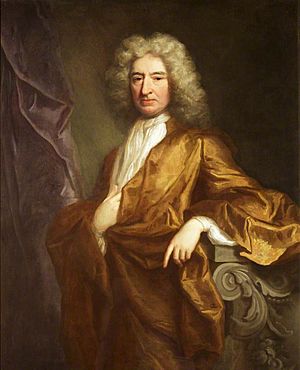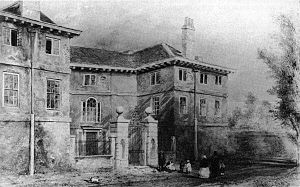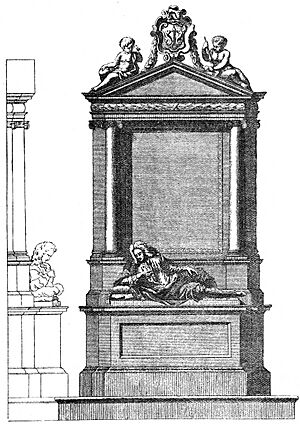Edward Colston facts for kids
Quick facts for kids
Edward Colston
|
|
|---|---|

Portrait by Jonathan Richardson
|
|
| Member of Parliament for Bristol | |
| In office 1710–1713 |
|
| Personal details | |
| Born | 2 November 1636 Bristol, England |
| Died | 11 October 1721 (aged 84) Mortlake, Surrey, England |
| Resting place | All Saints' Church, Bristol |
| Political party | Tory |
| Relatives | Edward Colston (nephew) |
| Occupation | Merchant |
Edward Colston (born November 2, 1636 – died October 11, 1721) was an English merchant and a philanthropist (someone who gives a lot of money to good causes). He was also involved in the slave trade. For a time, he was a Member of Parliament for the Tory party.
Colston became a successful merchant, trading goods like wine, fruits, and fabrics across Europe. Later, he became a leader in the Royal African Company. This company had a special permission from the English government to trade in gold, ivory, and enslaved people from West Africa.
Colston used his wealth to help build and support schools, hospitals, and homes for the poor in Bristol and other places. Many buildings and places in Bristol were named after him, and a statue of him was put up in 1895.
However, as people learned more about his role in the slave trade, there were protests. In June 2020, during protests supporting Black Lives Matter, his statue was pulled down and pushed into Bristol Harbour. After this, many places in Bristol that were named after him, like Colston Hall, changed their names.
Contents
Who Was Edward Colston?
His Early Life in Bristol
Edward Colston was born on November 2, 1636, in Bristol, England. His family had lived in the city since the late 1200s. His father, William Colston, was a rich merchant.
Edward grew up in Bristol until the English Civil War started. During the war, his family moved to London, and he went to a school called Christ's Hospital. The war made Colston believe strongly in order and the monarchy (rule by a king or queen).
Becoming a Merchant
In 1654, Colston began training to become a merchant. By 1672, he was a successful trader in London. Like his father, he bought and sold textiles from London. He also imported oils, wine, and sherry from Spain and Portugal. He even traded silk with Virginia and cod fish from Newfoundland to Italy.
Involvement in the Slave Trade
In 1680, Colston joined the Royal African Company. This company had a special right from the King of England to trade along the west coast of Africa. They traded in gold, silver, ivory, and enslaved people. Colston became a deputy governor of the company from 1689 to 1690. He left the company in 1692.
During the time Colston was involved, the Royal African Company transported over 84,000 African men, women, and children. They were taken across the Atlantic Ocean to the Caribbean and other parts of the Americas. Sadly, about 19,000 of these people may have died during the journey. The enslaved people were then sold to work on plantations, especially those growing tobacco and sugar.
Colston also became involved in the sugar business in Bristol. He lent money to the city and became a member of the Society of Merchant Venturers, a group of important merchants.
Colston's Generosity and Beliefs
Giving to Charity
Edward Colston used his wealth to support many good causes. He helped schools, homes for the poor, hospitals, and churches in Bristol, London, and other places.
In 1691, he founded Colstons Almshouses in Bristol. This was a home for 24 poor men and women. He also helped fund the merchant's almshouses in King Street. He supported Queen Elizabeth's Hospital school as well.
In 1696, he helped fund a school to clothe and teach 40 boys. He also built and supported a large school for 100 boys in 1708. He gave money to other schools in Bristol and to the Bristol Cathedral.
His Political and Religious Views
Colston was a Tory and a strong supporter of the High Church (a traditional part of the Church of England). He used his money to promote his beliefs and oppose other religious groups. He was a Member of Parliament for Bristol from 1710 to 1713.
His Death and Legacy

Edward Colston died on October 11, 1721, at his home in Mortlake, near London. He was 84 years old. He wanted a simple burial, but his wishes were not followed. His body was brought to Bristol and buried at All Saints' Church, Bristol. A large monument was built for him there.
Colston never married. He left a lot of his money and land to his nephew, also named Edward Colston.
Memorials and Changing Views
Buildings and Statues

For a long time, many places in Bristol were named after Edward Colston. These included the Colston Tower and Colston Hall (now called Beacon Tower and Bristol Beacon). Streets like Colston Avenue and Colston Street still carry his name. There was also a special bread bun called the Colston bun.
A statue of Colston was placed on the outside of Bristol Guildhall. In 1870, a stained-glass window in St Mary Redcliffe church was dedicated to him. The largest window in Bristol Cathedral also honored his memory.
The City-Centre Statue

In 1895, a statue of Edward Colston was put up in the center of Bristol. It was meant to celebrate his charity work. However, in 1920, a book about his life revealed more details about his involvement in the slave trade.
From the 1990s onwards, people started asking for the statue to be changed or removed. They wanted a plaque to explain that he was a slave trader. There was a long discussion about what the plaque should say.
On June 7, 2020, during protests supporting Black Lives Matter, the statue was pulled down. Protesters pushed it into Bristol Harbour. Four days later, the city council took the statue out of the water. It is now on display at Bristol's M Shed museum, shown in its damaged condition.
Modern Reappraisal
Historians say that Colston's involvement in the slave trade happened before the movement to end slavery began. At that time, slavery was generally accepted in England and Europe.
However, since the 1990s, people have become more aware of Colston's role in the slave trade. Many believe that his charity work does not make up for his involvement in such a terrible business.
The exact amount of Colston's wealth that came from the slave trade is not known. He also earned money from trading other goods and lending money.
Name Changes in Bristol
Because of the protests, many places in Bristol have changed their names:
- In 2017, Colston Hall, a concert venue, announced it would change its name. It became the Bristol Beacon in September 2020.
- In 2020, Colston's Girls' School changed its name to Montpelier High School.
- In 2018, Colston Primary School renamed itself Cotham Gardens Primary School.
- In 2019, St Mary Redcliffe and Temple School renamed its Colston house (a school team) after the American mathematician Katherine Johnson.
- A pub formerly known as the Colston Arms changed its name to the Open Arms in 2021.
- In 2018, the Lord Mayor of Bristol had a portrait of Colston removed from her office. She said it would be better displayed in a future Museum of Abolition.
Many people believe that Colston's charitable actions do not excuse his role in transporting thousands of Africans into slavery. They see the money he gave as "blood money."
|
See also
 In Spanish: Edward Colston para niños
In Spanish: Edward Colston para niños
- Anchor Society
- Bristol slave trade


